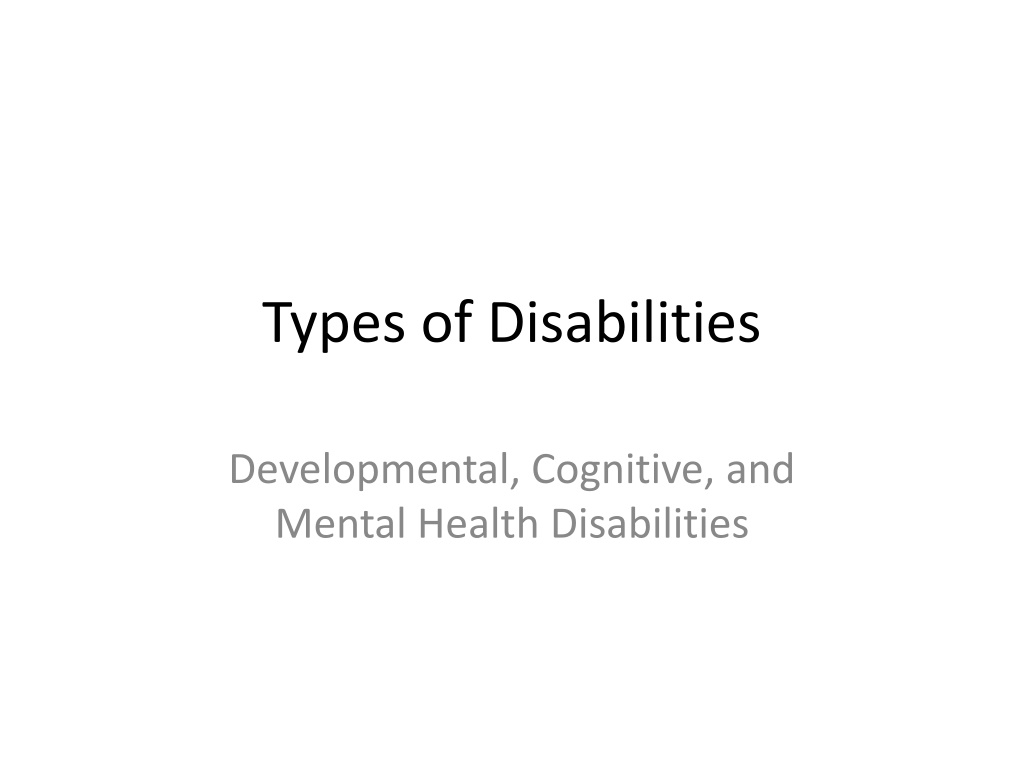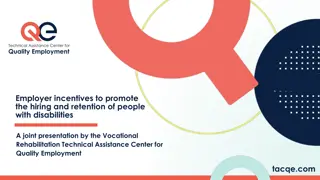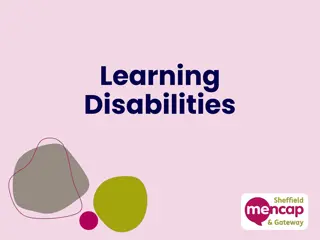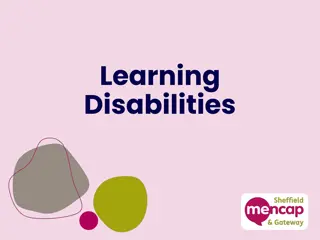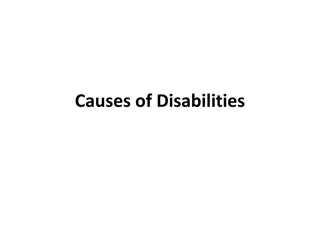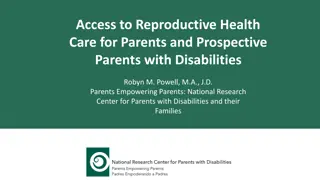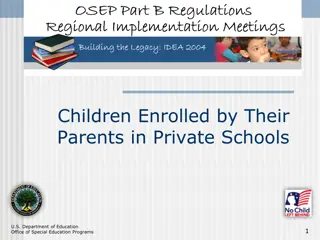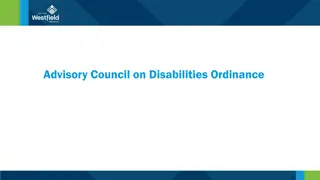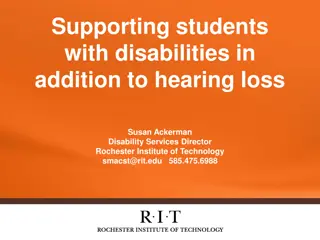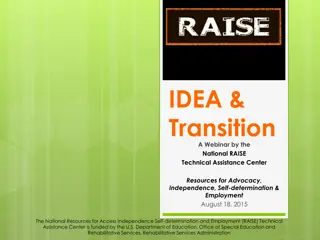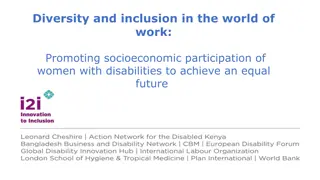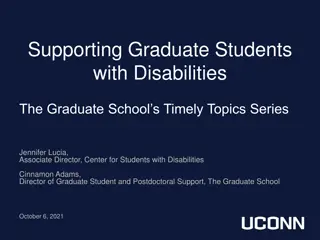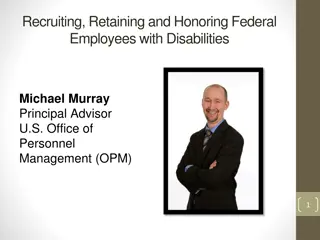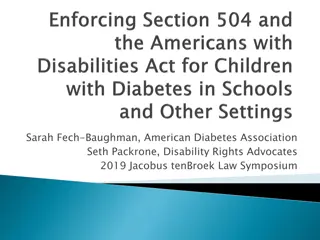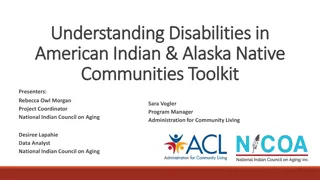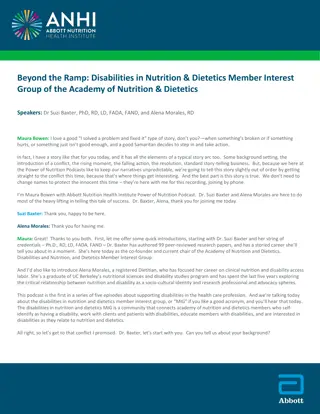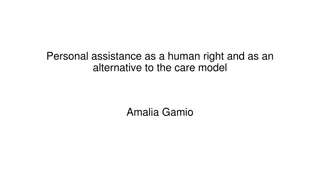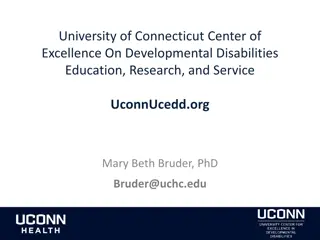Types of Disabilities
Developmental disabilities encompass conditions like intellectual disability, autism, Down syndrome, and more. Cognitive disabilities affect learning, reasoning, and social skills. Intellectual disability involves significantly impaired cognitive functioning.
Download Presentation

Please find below an Image/Link to download the presentation.
The content on the website is provided AS IS for your information and personal use only. It may not be sold, licensed, or shared on other websites without obtaining consent from the author.If you encounter any issues during the download, it is possible that the publisher has removed the file from their server.
You are allowed to download the files provided on this website for personal or commercial use, subject to the condition that they are used lawfully. All files are the property of their respective owners.
The content on the website is provided AS IS for your information and personal use only. It may not be sold, licensed, or shared on other websites without obtaining consent from the author.
E N D
Presentation Transcript
Types of Disabilities Developmental, Cognitive, and Mental Health Disabilities
Developmental Disabilities Developmental disabilities (DD) is an umbrella term for multiple conditions emerging from anomalies in development. The essential feature of DD is onset prior to adulthood and the need for significant, lifelong supports. Conditions commonly encompassed under DD are intellectual disability, autism, down syndrome, cerebral palsy, epilepsy, among others.
Cognitive Disabilities Cognitive disabilities are disabilities that affect an individual's ability to comprehend what he or she sees and hears. For people with cognitive disabilities, learning ability, reasoning, judgment, social skills develop at a slower-than- average pace. Individuals with cognitive disabilities may have difficulty learning new things, generalizing from specifics, and using language for expression in both oral and written form. Cognitive disabilities include learning disabilities, intellectual disabilities, traumatic brain injury, autism, and Down syndrome.
Intellectual Disability Intellectual disability is a situation in which a person s overall intellectual functioning is well below average, with an intelligence quotient (IQ) around 70 or less. Individuals with intellectual disability have a significantly impaired ability to cope with common life demands and lack some daily living skills expected of people in their age group and culture (significant impairment in the areas of learning, communication, self-care, independent living, social interaction, play, work, and safety).
Degree of Severety Four degrees of severity of intellectual disability based on IQ score are: mild (IQ range 50-55 to about 70) moderate (IQ range 35-40 to 50-55) severe (IQ range 20-25 to 35-40) profound (IQ level below 20-25). People of average intelligence score from about 90 to 110 on IQ tests.
People with Mild and Moderate Intellectual Disability People with mild intellectual disability could achieve employment on a semi-skilled or unskilled level, function independently, may own their own homes, and generally lead familial life. People with moderate intellectual disability might achieve self-maintenance in unskilled or semi- skilled work, sometimes under accommodated work environments, including sheltered conditions and supported employment.
People with Severe and Profound Intellectual Disability People with severe intellectual disability might help in their own maintenance but generally require supervision in work and living environments. People with profound intellectual disability have limited motor and speech skills, might achieve limited self-care and needed extensive attendant or nursing care.
Causes of Intellectual Disabilities Causes of intellectual disability include genetic conditions (disorders that occur as a fetus develops during pregnancy including chromosomal disorders such as Down syndrome); fetal alcohol syndrome; malnutrition; a mother s use of alcohol or drugs; viral infections; premature birth; infectious diseases which could be easily prevented through immunization during childhood; brain damage; and other problems during or after birth.
Treatment/Provision Professionals can help people with intellectual disabilities and their families understand their rights, maximize their potential, and develop resources. In order to achieve their potential, children with intellectual disabilities may need special education and training, which ideally begins in infancy and continues until they establish an adult role. Job coaching in employment and shelterd workshop facilities may be also provided.
Learning Disabilities The term learning disabilities refers to a group of neurological disorders that impact one or more of the brain s basic functions used to understand and interpret language, symbols, and gestures The manifestation of these neurologically based conditions can be observed in an individual s difficulty with reading, writing, listening, speaking, completing mathematical functions, fine motor skills, and even interpreting social cues and gestures.
Characteristics of LD Difficulty in discriminating fine differences in auditory, visual, and/or tactile input; decreased ability to retain and recall discriminating sounds and forms both in the short term and the long term; difficulty remembering the correct sequence of steps necessary to complete a task; difficulty with figure-background relationships and distinguishing which is which; difficulties with time and space orientation
Characteristics of LD (cont) Difficulty bringing closure to either a concept or a physical form; difficulties integrating input from two or more senses; difficulty judging the energy requirements of performing a specific task; difficulty viewing specifics in relation to the whole; and attention disturbances
Types of Learning Disabilities Dyslexia: difficulty in understanding language and using various language-related skills Dyscalculia: difficulty in learning and understanding mathematical concepts and operations. Dysgraphia: difficulty in developing and using written language Dysnomia: difficulty in recollection of names, places, or specific object words. Dyspraxia: difficulty in manipulation of fine motor skills
Treatment/Provisions Teaching different skills Teaching the use of multiple learning modalities visual, tactile, auditory Providing tutors, note takers, extra time for testing, alternative format versions of textbooks, and environmental arrangements such as areas with reduced distraction for work and testing. Providing technological devices such as tape recorders, calculators and word processing software, speech synthesizers, voice recognition software and talking dictionaries.
Autism Autism affects the social, emotional, and behavioral development of children. Thus, autism is defined upon three symptoms areas: social difficulties, communication difficulties, and restrictive interests or repetitive behaviors. The autism spectrum ranges from highly verbal, high-functioning individuals with superior intelligence, to nonverbal persons with low IQs.
Symptoms Hyperactivity and impulsivity, extreme anger and aggressiveness, self-injurious behaviors insist on doing things in exactly the same way or on following the same routine and may become very upset in response to a minor change in the routine, serious difficulty in interacting and communicating with other people, constantly repeating certain actions or behaviors, or having intense interests restricted to only particular things or topics.
Causes and Treatment Genetic causes, brain abnormalities, infections and drugs taken by pregnant mothers. Treatment includes the use of individualized education, communication tools, behavioral management, and medication, play sessions, therapy and training approaches. Parents, teachers, and therapists need to work together to help a child gain new skills and abilities.
Attention-Deficit Hyperactivity Disorder Attention-Deficit Hyperactivity Disorder (ADHD), beginning in childhood, is characterized by a persistent inability to sit still, focus attention on specific tasks, and control impulses. A person with ADHD may have difficulty with school, work, friendships, or family life. Children and adults with ADHD consistently show various degrees of inattention, hyperactivity, and impulsiveness.
Hyperactivity/Impulsivity Hyperactivity and impulsivity: constant motion, as if driven by a motor; children may squirm and fidget at their desks in school, get up often to roam around the room, constantly touch things, disturb other people, tap pencils, and talk constantly, act before thinking, may run into the street without looking, blurt out inappropriate comments in class, interrupt conversations, and be unusually clumsy or accident-prone.
Inattention; Types of ADHD Inattention: people with ADHD have difficulty keeping their minds on one thing; may get bored with homework or other tasks after a few minutes, make careless mistakes, have trouble in listening. There are three predominant types of ADHD: inattentive, hyperactive/impulsive, and combined.
Problems of People with ADHD Children with ADHD: have learning problems because of difficulties in paying attention, following instructions, and completing tasks; become unpopular with peers because of disruptive and demanding behavior; receive constant criticism and correction from teachers and parents, who believe the behavior is intentional; and subsequently develop low self- esteem and other emotional problems Adults with ADHD: become impatient and restless and bored before finishing a task; fail to organize their time; have difficulty in maintaining friendships and other relationships; are more likely to develop other mental illnesses such as anxiety, depression, and substance-related problems.
Causes and Treatments Genetic factors, trauma to the brain, damage to the fetus by substance abuse, premature birth, and other biological disorder resulted from abnormalities in the brain cause ADHD. Treatment may include medication, counseling, social skills training, special academic tutors, and parental skills training.
Mental Health and Mental Illness Mental health is the state of relative psychological and emotional well-being whereby an individual can make acceptably rational decisions, cope adequately with personal and external stresses, and maintain satisfactory adjustment to society. Mental illness is any of a wide range of psychological, emotional, or cognitive disorders that impair a person's ability to function effectively.
Causes and Symptoms Causes may be biological, physiological, genetic, psychological, or social. Primary symptoms of mental illness include extreme anxiety, disturbed thinking processes, perceptual distortions, extreme mood variations, and other difficulties in thinking.
Types of Psychiatric Disabilities schizophrenia and other psychotic disorders, mood disorders, anxiety disorders, personality disorders, impulse control disorders
Schizophrenia Schizophrenia is a severe mental disturbance characterized by delusions; hallucinations; confused, incoherent speech; bizarre behavior; short, empty verbal responses that lack attentiveness; and inability to participate in goal-directed activities.
Mood Disorders Mood disorders are mental disorders involving extreme disturbances in a person's mood. Specific diagnostic classifications of mood disorders include depressive disorders and bipolar disorders.
Depressive Disorders Depressive disorders are characterized by unhappiness, lack of interest in daily activities, inability to experience pleasure, pessimism, significant weight loss or weight gain not related to dieting, insomnia, feelings of hopelessness and worthlessness, decreased capacity to focus and make decisions, and preoccupation with thoughts of suicide and death.
Bipolar Disorder Bipolar disorder (also known as manic-depressive disorder) involves mixed or extreme mood swings resulting in abrupt changes from manic to depressive episodes. With bipolar disorders, people may experience primarily manic episodes characterized by abnormally elevated affect, feelings of euphoria, and excessive movement or talk. With other bipolar disorders, people may experience primarily periods of depression and at least one hypo-manic episode.
Anxiety Disorders Anxiety disorders are persistent or periodic states of extreme anxiety characterized by excessive fear, panic, worry, apprehensiveness, and dread of the future. Physical symptoms include a rapid pulse, dizziness, perspiration, cold hands or feet, and rapid breathing.
Personality Disorders Personality disorders reflect long-term patterns of behavior, emotions, and views of self and the world that strikingly diverge from cultural expectations, cause considerable stress, and result in problematic social interactions. The most common personality disorders include paranoid, antisocial, narcissistic, avoidant, dependent, and obsessive-compulsive.
Impulse Control Disorder Impulse control disorders are conditions in which people are unable to resist the temptation to participate in some activity that causes them or others harm or regret. Usually, people with such disorders follow a cycle of succumbing to extreme temptation, participating in the activity, getting a real high during the activity, and suffering extreme remorse and guilt afterward.
Treatment/Intervention Drug therapy; psychotherapy (including psychodynamic therapy, humanistic therapy, behavioral therapy, cognitive therapy, play therapy, group and family therapy); rehabilitation and skill training programs; advocacy; and psychosurgery.
